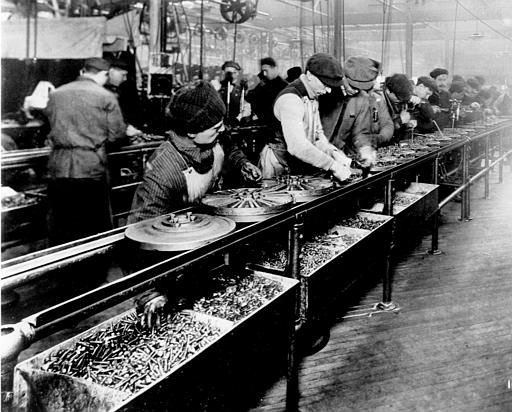
The Industrial Revolution was a period from the 18th to the 19th century where a lot of things were changing in agriculture, manufacturing, mining, transport, and technology had mostly effected the socioeconomic and cultural conditions that started in the United Kingdom then spread throughout Europe, North America and eventually the world.
Before the Industrial Revolution everything was made by hand but now with the Industrial Revolution everything has changed. Powers and streams were created to mechanize the textile industry. Suddenly mills and factories were producing textiles. Soon the factories weren't doing only textiles but furniture and also everyday items. Many farmers were leaving from their farms and moved in the cities where they worked in factories.

 |
| Cotton Spinning Machine |
Then there was Samuel Slater that brought the industrial revolution to America. He designed the textile mills. He learned textile machinery as an apprentice to a pioneer in the British industry. He brought the knowledge to America, He also designed the textile mills in America and reconstructed a cotton spinning machine from his memory of the blueprint although it was illegal to bring any Industrial Revolution ideas to America because these ideas gave Britain an advantage over America.
 |
| The Assembly Line |
 | |||||||
| Women working in the Assembly Line |
But workers did not let this condition go down, in the 19th beginning of the 20th century there were over 10,000 strikes! And riots against the capital class. This was also at the same time that the rich guy over the richer built massive mentions to live like kings. The poor lived in rundown tennis. It wasn't until the 20th Century with what's called the progressive era, a government started intervening the past laws of these harsh consequences of the Industrial Revolution.
The 19th Century London boasted the steam engine, world's first underground railways and the first photograph.
 |
| Steam Engine |
 |
| 1st Underground Railway |
 |
| 1st Photograph |
The Great Exhibition (The Crystal Palace)
| The Great Exhibition, 1851 (Front View) |
 |
| (The Interior) of the Crystal Palace |
The Great Exhibition of 1851 was held at the Crystal Palace in London. This was a building created by the architecture, Joseph Paxton. It took 9 months to be done. The building was mostly made by iron and glass. It became known as the 'Crystal Palace', the purpose of the Exhibition was to bring together exhibits from all over the world. It's enormous as it covered 17 acres. Full grown trees were fit inside the palace. There were flags on the outside and flags on the inside, there were great fountains on the outside and on the inside.On the inside it was very colourful and so much to see! There were sculptures from Belgium, India's Hall, Model Boats, Canadian Hall, Furniture Galleries, Chinese Court, the Russian Hall, United States wing, the Hardware section and so much other interesting things.
Reference:
CC-BY-SA, 2014. Industrial Revolution. [Online] Available at: <http://www.princeton.edu/~achaney/tmve/wiki100k/docs/Industrial_Revolution.html> [Accessed 27 February 2014].
Cohen, Isaac. American Management and British Labor: A Comparative Study of the Cotton Spinning Industry. New York: Greenwood Press, 1990. [Online] Available at: <http://www.answers.com/topic/industrial-revolution> [Accessed 27 February 2014].
A&E Television Networks LLC, 2014. The Industrial Revolution. [Online] Available at: <http://www.history.com/topics/industrial-revolution/videos/the-industrial-revolition?m=528e394da93ae&s=undefined&f=1&free=false> [Accessed 27 February 2014].
Worldstaracademy, 2010.The Great Exhibition of 1851. [Video Online] Available at:<https://www.youtube.com/watch?v=eqM6PXyp5MA> [Accessed 27 February 2014].
Short Notes:
o Greek -Classical
-Hellenistic-(Alexander the Great-exaggerated movements)
-Archaic
o Roman -They were good at war + weapons
- Infrastructure (communication)
-Aqueducts (transportation of water)
-They invented concrete
o Early Christians -Period of Christianity
o Byzantine -Were inspired by the Greek, Turkey etc.
-(Constantine the Great)
o Middle Ages -> Charlemagne
-> Romanesque (looks like Roman architecture)
-> Gothic
The vikings were good in sailing, navigating and making weapons
o Renaissance -Rinascimento - (Re-Birth)
|
Re-Birth of Good Art
o Baroque -misshapen in form
o Rococo -Development of Baroque
|
(French Baroque)
End of 18th Century -Luis IV/II/VI

No comments:
Post a Comment